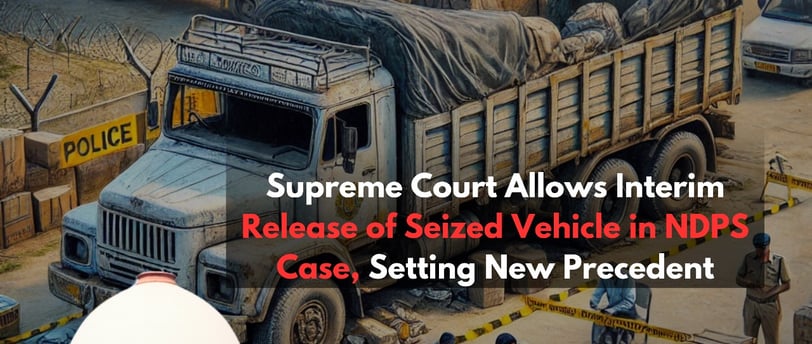Supreme Court Allows Interim Release of Seized Vehicle in NDPS Case, Setting New Precedent
In a landmark judgment delivered on January 7, 2025, the Supreme Court of India allowed the interim release of a truck seized under the Narcotic Drugs and Psychotropic Substances Act (NDPS Act). The judgment, delivered in the case of Bishwajit Dey vs. The State of Assam, addresses crucial legal questions surrounding the ownership and interim release of vehicles involved in drug trafficking cases.
1/14/20253 min read


In a landmark judgment delivered on January 7, 2025, the Supreme Court of India allowed the interim release of a truck seized under the Narcotic Drugs and Psychotropic Substances Act (NDPS Act). The judgment, delivered in the case of Bishwajit Dey vs. The State of Assam, addresses crucial legal questions surrounding the ownership and interim release of vehicles involved in drug trafficking cases.
Case Background
The appellant, Bishwajit Dey, a truck owner, sought the release of his vehicle seized during a police operation in Assam. On April 10, 2023, the truck, bearing registration number AS-01-NC-4355, was stopped at a police checkpoint and searched. The authorities found 24.8 grams of heroin concealed in black polythene inside the truck. The main accused, Md. Dimpul, was arrested on the spot, while neither the truck’s owner nor its driver was implicated in the crime.
The truck, purchased on a monthly loan installment of ₹1,00,020, was the appellant's sole source of livelihood. The Gauhati High Court had earlier denied interim release, prompting the appeal to the Supreme Court.
Arguments Presented
The appellant argued that neither he nor his driver was aware of the contraband hidden in the truck. They emphasized that the accused, a passenger, was solely responsible for the possession of the illegal substance. Further, the appellant pointed out the deteriorating condition of the vehicle, lying exposed to the elements in police custody. He relied on precedents such as Sunderbhai Ambalal Desai v. State of Gujarat (2002) and Bhola Singh v. State of Bihar (2016), where courts had allowed the release of seized vehicles with safeguards.
The State of Assam opposed the appeal, contending that the NDPS Act is a stringent law designed to combat drug trafficking, and its provisions override general procedural laws like the Code of Criminal Procedure (CrPC). They argued that releasing the vehicle could risk its reuse for illegal activities.
Key Legal Issues and Court's Reasoning
Bar on Interim Release:
The State argued that the NDPS Act prohibits the interim release of vehicles used in drug trafficking. The Court, however, clarified that while the NDPS Act provides for confiscation of vehicles used for transporting contraband, it does not explicitly bar their interim release. Sections 451 and 457 of the CrPC could, therefore, be invoked to allow such release during the trial.
Ownership and Knowledge:
The Court distinguished between scenarios where the vehicle owner or their agent is implicated and those where the vehicle is used without the owner’s knowledge. It noted that the appellant was neither named in the chargesheet nor accused of facilitating the transport of drugs. This lack of complicity justified the interim release.
Preservation of Evidence:
Acknowledging the truck's significance as evidence, the Court directed that detailed videography and photography of the vehicle be conducted before its release. This documentation, authenticated by the investigating officer, owner, and accused, would ensure its availability for the trial.
Balancing Competing Interests:
The Court highlighted the adverse consequences of prolonged police custody of the vehicle. It observed that vehicles left unattended often suffer significant depreciation and damage. By releasing the truck, the owner could resume his livelihood, repay loans, and contribute to the economy, while safeguards would ensure the vehicle's availability for trial.
Broad Implications of the Judgment
The Court categorized cases involving the seizure of vehicles into four scenarios:
The owner is directly involved in the crime.
The owner’s agent (e.g., driver) is involved.
The vehicle is stolen and used for illegal activities.
The vehicle is used without the owner’s knowledge or consent.
It emphasized that while interim release may not be appropriate in the first two scenarios, it should be considered in the latter two, provided safeguards are implemented.
Conclusion and Directions
Allowing the appeal, the Supreme Court ordered the truck's release with specific conditions:
Preparation of a video and photographic record.
Authentication of records by all parties involved.
A bond ensuring the truck's availability during trial or compensation equivalent to its value, should confiscation be ordered.
A prohibition on the sale or transfer of the vehicle until the trial concludes.
This judgment serves as a guiding precedent, ensuring a balanced approach to handling seized property in NDPS cases. It underscores the judiciary's commitment to protecting property rights while upholding the objectives of stringent drug laws.
